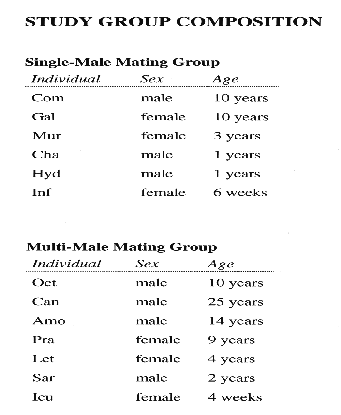
Male
Infant Care in Ruffed Lemurs (Varecia Variegata ):
Parental Investment or Access to Mates?
Margaret B. Scott and Frances
J. White*
Biology Department, Davidson College, and *Biological Anthropology and Anatomy Department, Duke University
ABSTRACT
Infant care and male associations were
studies in two reproductively unique groups of free-ranging ruffed lemurs
at the Duke University Primate Center. The groups were housed in separate
natural habitat enclosures and consisted of one single-male mating group
of red ruffed lemurs (Varecia variegata rubra) and one multi-male
mating group of black and white ruffed lemurs (V. v. Variegata).
Five minute focal animal sampling was used to record individual behavior
and group interactions. Nearest neighbor frequency to infants and mothers,
frequency of affiliative interactions, and nearest neighbor distance were
used for statistical analysis (goodness of fit test and test for independence).
Within the multi-male mating group, one male was the infant's nearest neighbor
or second nearest neighbor 54.70% of the time, positively associating with
the infant significantly more often than any other group member excluding
the mother. The same male, the suspected father, was also the mother's most
frequent adult nearest neighbor and was the only adult male observed to
positively affiliate with the mother. In contrast, the known father in the
single-male mating group spent only 34.67% of the time as a neighbor to
the infant and did not positively interact with the infant significantly
more or less often than any other group member excluding the mother. However,
the single adult male did spend significantly more time as his daughter's
nearest neighbor rather than his mate's, and was not observed to affiliate
with the mother. Comparison of the males revealed a significant difference
in the nature of the male- female associations, variation in the extent
of male-infant interactions, and the significant effect of female presence
on male-infant associations. Together, these observations suggest that male
mating and parenting strategies vary between single-male and multi-male
mating groups. Moreover, the data imply that while there may be a minimum
care requirement for infants, direct male care as observed Varecia
may represent a mating effort and not simply a parental investment.

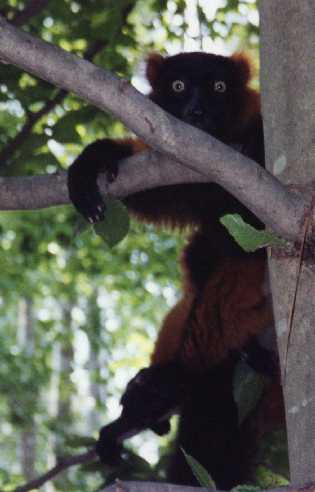
Amo was the infant's nearest neighbor or second nearest neighbor significantly more often than any other adult male in the multi-male mating group (G=283.0344, df=2, p<0.05). Comparison between the single-male and multi-male groups revealed that Amo also associated with the infant as a neighbor more frequently than did Com (G=37.260, df=2, p<0.05).
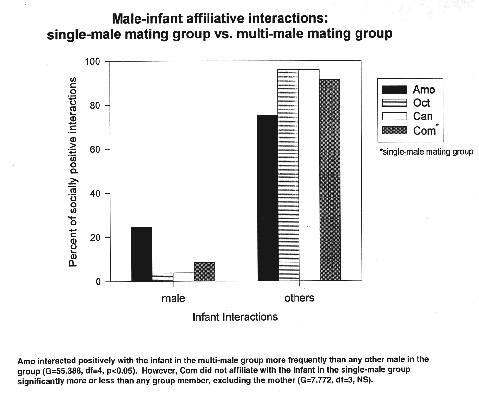
Amo interacted positively with the infant in the multi-male group more frequently than any other male in the group (G=55.388, df=4, p<0.05). However, Com did not affiliate with the infant in the single-male group significantly more or less than any group member, excluding the mother (G=7.772, df=3, NS).
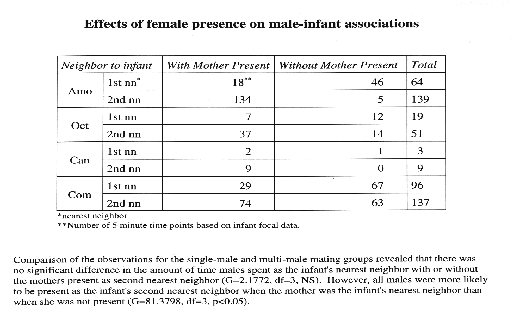
Comparison of the observations for the single-male and multi-male mating groups revealed that there was no significant difference in the amount of time males spent as the infant's nearest neighbor with or without the mothers present as second nearest neighbor (G=2.1772, df=3, NS). However, all males were more likely to be present as the infant's second nearest neighbor when the mother was the infant's nearest neighbor than when she was not present (G=81.3789, df=3, p<0.05).
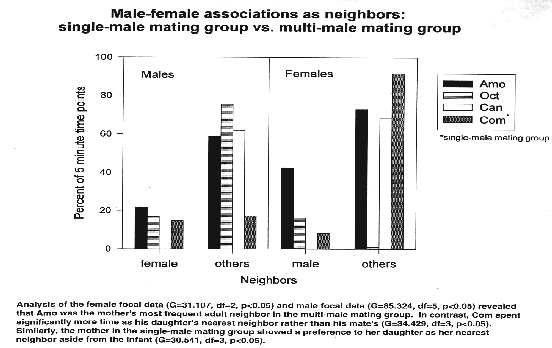
Analysis of the female focal data (G=31.107, df=2, p<0.05) and male focal data (G=85.324, df=5, p<0.05) revealed that Amo was the mother's most frequent adult neighbor in the multi-male mating group. In contrast, Com spent significantly more time as his daughter's nearest neighbor rather than his mate's (G=34.429, df=3, p<0.05). Similarly, the mother in this single-male mating group showed a preference to her daughter as her nearest neighbor aside from the infant (G=30.541, df=3, p<0.05).
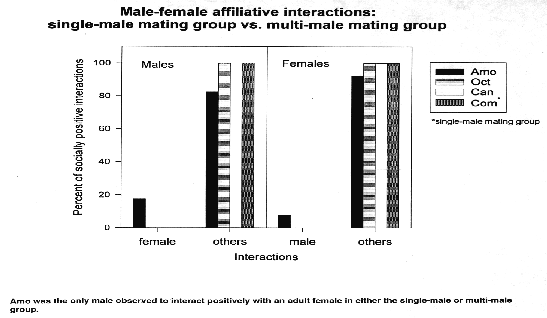
Amo was the only male observed to interact positively with an adult female in either the single-male or multi-male group.
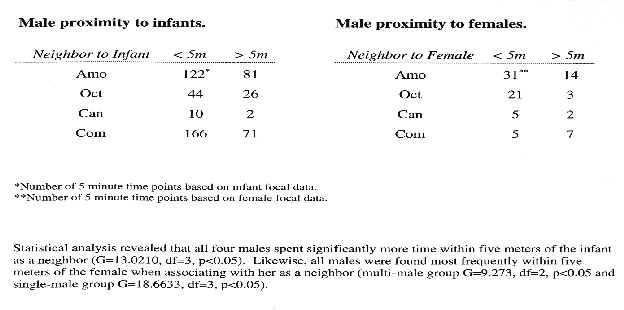
Statistical analysis revealed that all four males spent significantly more time within five meters of the infant as a neighbor (G=13.0210, df=3, p<0.05). Likewise, all males were found most frequently within five meters of the female when associating with her as a neighbor (multi-male group G=9.273, df=2, p<0.05 and single-male group G=18.6633, df=3, p<0.05).
© Copyright 2000 Department of Biology, Davidson
College, Davidson, NC 28036
Send comments, questions, and suggestions to: macampbell@davidson.edu